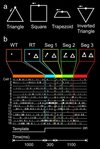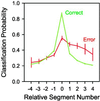Parallel processing of serial movements in prefrontal cortex
- PMID: 12242330
- PMCID: PMC130605
- DOI: 10.1073/pnas.162485599
Parallel processing of serial movements in prefrontal cortex
Abstract
A key idea in Lashley's formulation of the problem of serial order in behavior is the postulated neural representation of all serial elements before the action begins. We studied this question by recording the activity of individual neurons simultaneously in small ensembles in prefrontal cortex while monkeys copied geometrical shapes shown on a screen. Monkeys drew the shapes as sequences of movement segments, and these segments were associated with distinct patterns of neuronal ensemble activity. Here we show that these patterns were present during the time preceding the actual drawing. The rank of the strength of representation of a segment in the neuronal population during this time, as assessed by discriminant analysis, predicted the serial position of the segment in the motor sequence. An analysis of errors in copying and their neural correlates supplied additional evidence for this code and provided a neural basis for Lashley's hypothesis that errors in motor sequences would be most likely to occur when executing elements that had prior representations of nearly equal strength.
Figures




References
-
- Lashley K. In: Cerebral Mechanisms in Behavior. Jeffress L A, editor. New York: Wiley; 1951. pp. 112–136.
-
- Shallice T. Psychol Rev. 1972;79:383–393. - PubMed
-
- MacNeilage P F. Lang Speech. 1964;7:144–159.
-
- MacKay D G. Neuropsychologia. 1970;8:323–350. - PubMed
-
- Rumelhart D E, Norman D A. Cogit Sci. 1982;5:1–36.
Publication types
MeSH terms
Grants and funding
LinkOut - more resources
Full Text Sources

